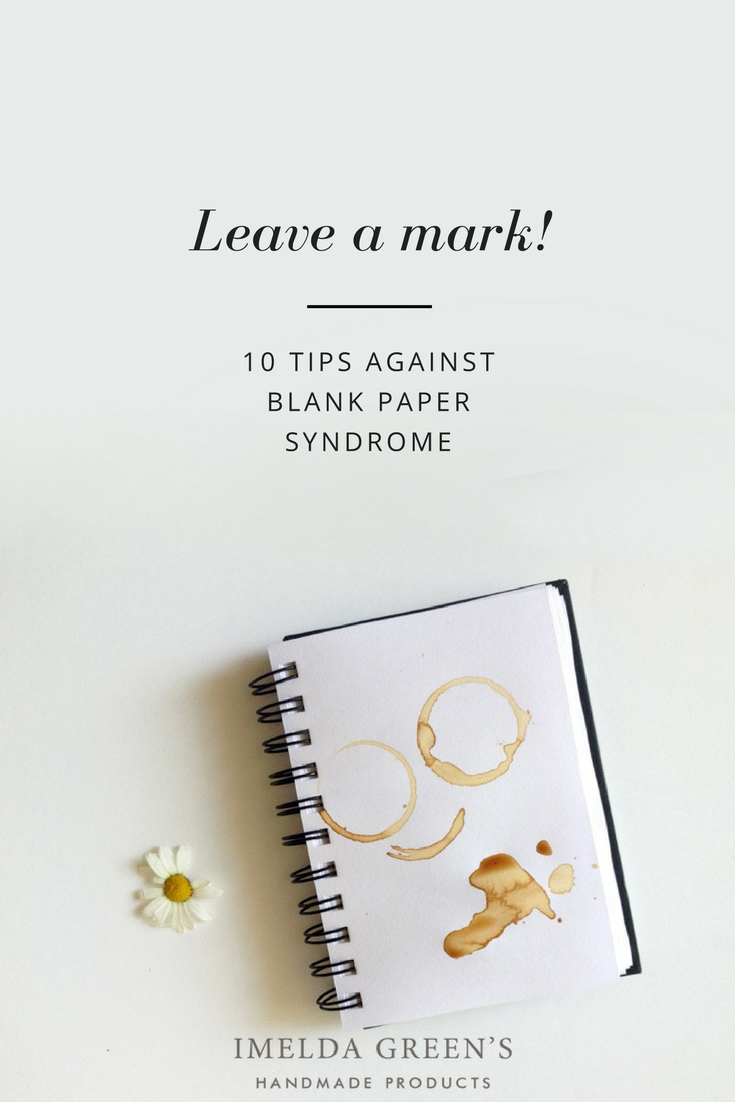Leave a mark – 10 tips against blank paper syndrome

I’m sitting above a blank piece of paper and I am simply unable to start… If only I drew the first line, it would be easier… But at the moment it seems unbelievable that this blank paper will soon be filled with something, something that I create…
The above case is well-known to (some) artists and is called blank paper syndrome. It is a paralyzing fear that stops you from starting your work. Of course it’s a good idea to meditate about what might cause this fear but luckily there is a quicker way of dealing with it: you just have to leave a mark on the paper/canvas.
One of the advantages of ‘mark-making’ is that the goal is not to produce a Work of Art (even though it usually ends up one), so your perfectionism will not tell you that you are not good enough (always assuming you are a perfectionist.. if you are not, that’s your great luck).
I have gathered a couple of ways below that will help you leave a mark on your blank surface. It might look like we are back to kindergarden, but it actually helps you re-connect with your creativity, and so it will be easier to start on a new piece later.
Repeat patterns
Don’t think about anything complicated. Just lines, one after the other, dots, raindrops, simple forms. Last year I completed a one-week challenge painting these, so for a bit of inspiration you can look around here.

Collage
Collages are a form of art that usually come up everywhere, from primary school art classes through confidence-trainings to art journals – not by accident. You can create really great and inspiring pieces without considerable talent in art.
Watercolour splash
This is one of my favourites, I even created a tutorial for painting splashes. I love seeing how the colours blend into each other. What’s more, once they are dry, you can cut them up and use them for a collage.
The bottom of your coffee mug
Has anyone ever moaned about cup-stains on the table that coffee mugs leave behind? (Hello, office workers!). Well, it is pretty easy to turn it into a creative project. How about a kitty?

Text on the artwork, artwork made of text
Handwriting actually leaves marks on the paper but somehow we tend to look at it as something different than ‘drawing letters’ so there is no block. And actually you can create pictures made of words just as well as lines and shapes. Think about calligrams!
Prints
Fingerprints, for example. It is very easy to fill a blank paper with fingerprints. You can even compare the marks made by different fingers. Or, you could think big, like Yves Klein. But you can also try the different prints that textiles leave (once you paint them in acryllic, for instance), or just paint one page of a notebook, then close the notebook while the paint is still wet. The opposite page will definitely be printed with something exciting!
A hundred things you can do with your hands
Do you remember that fabulous kindergarden task, when you had to draw an outline of your hand? For some reason this was one of my favourites and I kept drawing my hand well after kindergarden, always filling the shape with something different. But apart from finger prints, you can also use your fingers as a paintbrush. It’s alright to get smudged. :)
Blow it
You can create random forms if you use a wet kind of paint (like ink) and you blow at it from different angles. As the forms will be completely accidental, this is a really useful exercise for control-freaks. If you don’t feel like blowing it, you can also lift the paper and tilt it, so the paint will flow around.

Spray with a toothbrush
This technique is particularly useful if you want to paint snowfall or rain, but you can also achieve a really cool effect just by spraying around the blank paper. If you cover a certain area with masking fluid or a simple shape cut out from paper, you can create negative patterns.
Paint it in a single colour
Let’s play Mondrian! Can you create as even a surface as he did? (hint: it depends on your paint, too). If not, what kind of patterns does your unevenness produce? Try to see shapes and forms in the ‘mistakes’! Later you can work on them and turn them into patterns.
These techniques are perfect if you want to be creative but you feel bound by expectations. They can also be the first steps for you to find your creativity again after a long break – not to mention that most of them are really quick to make, so you don’t need to have an entire evening just for yourself.
Try some of them, then share your creations in the comments below!


